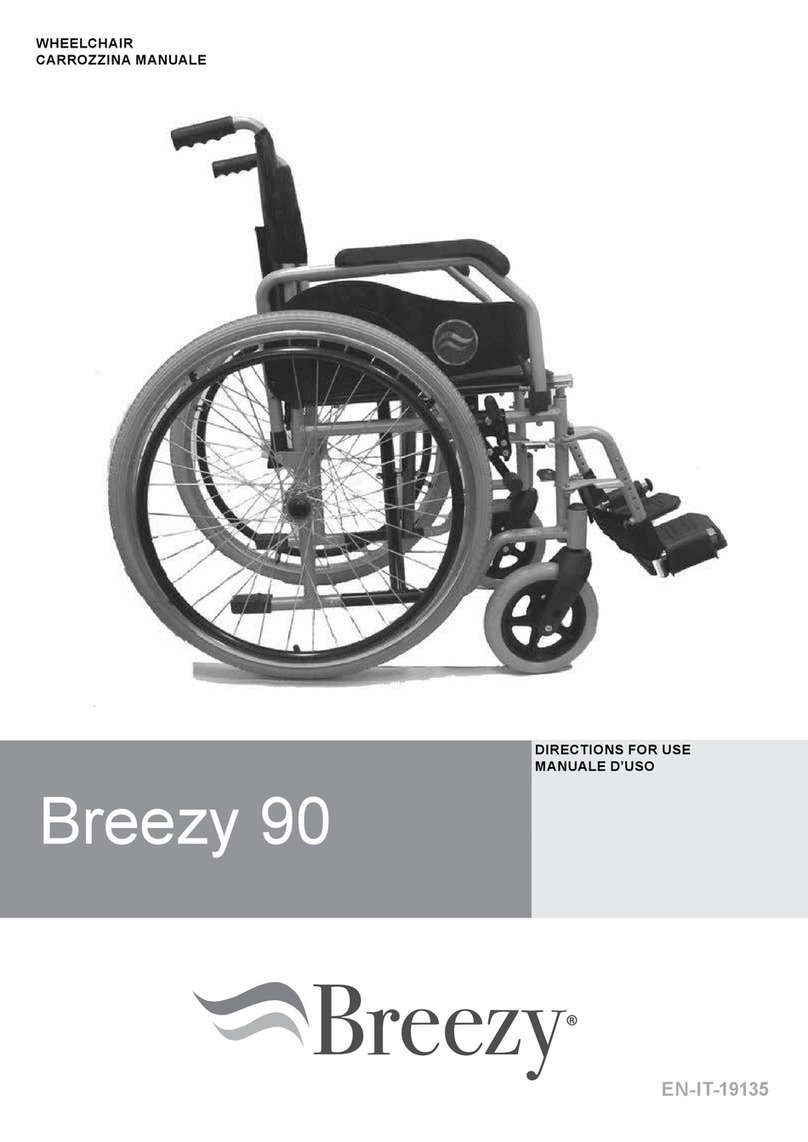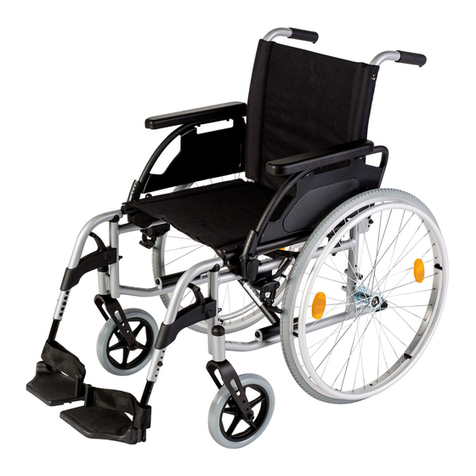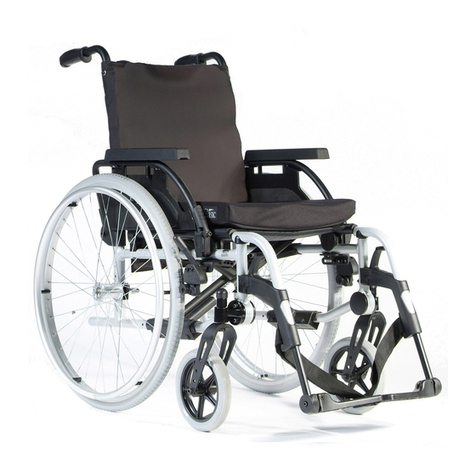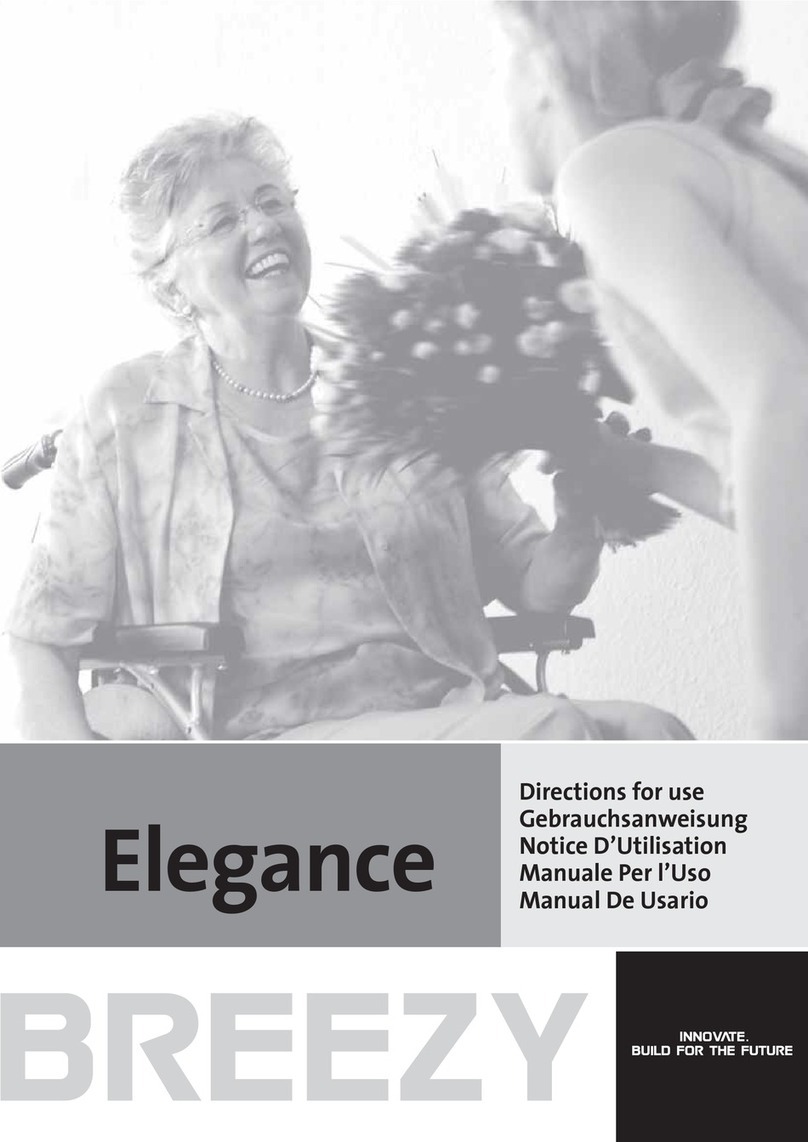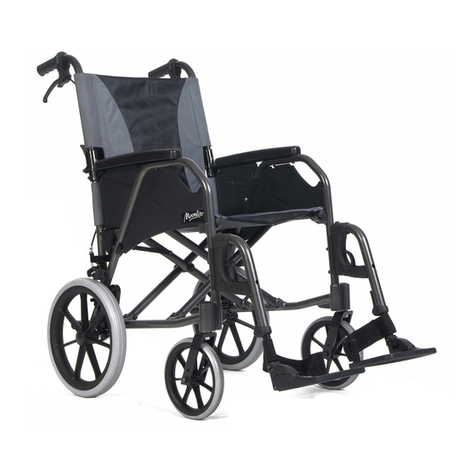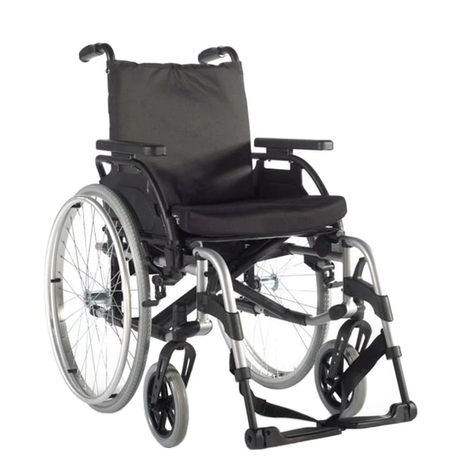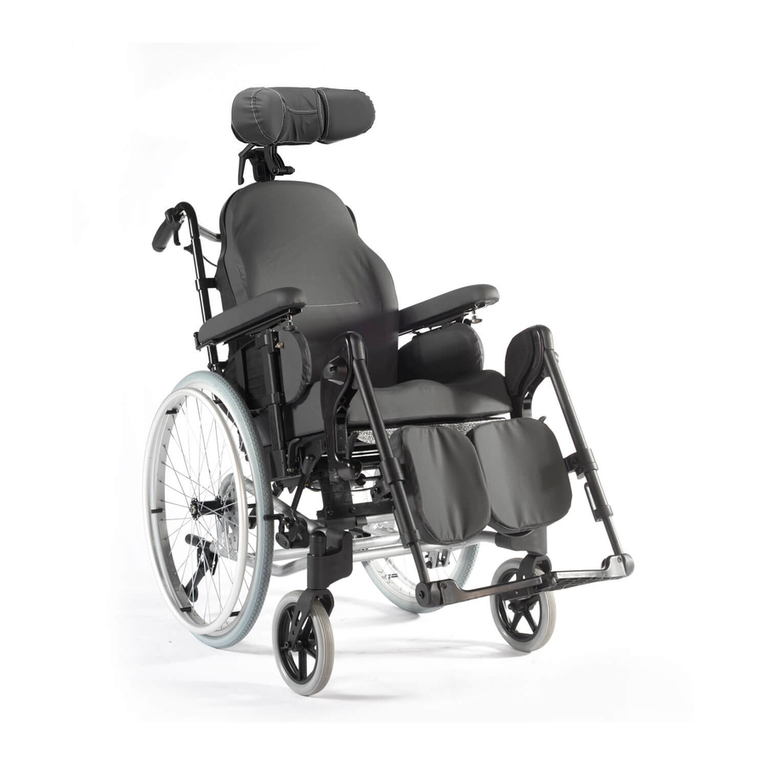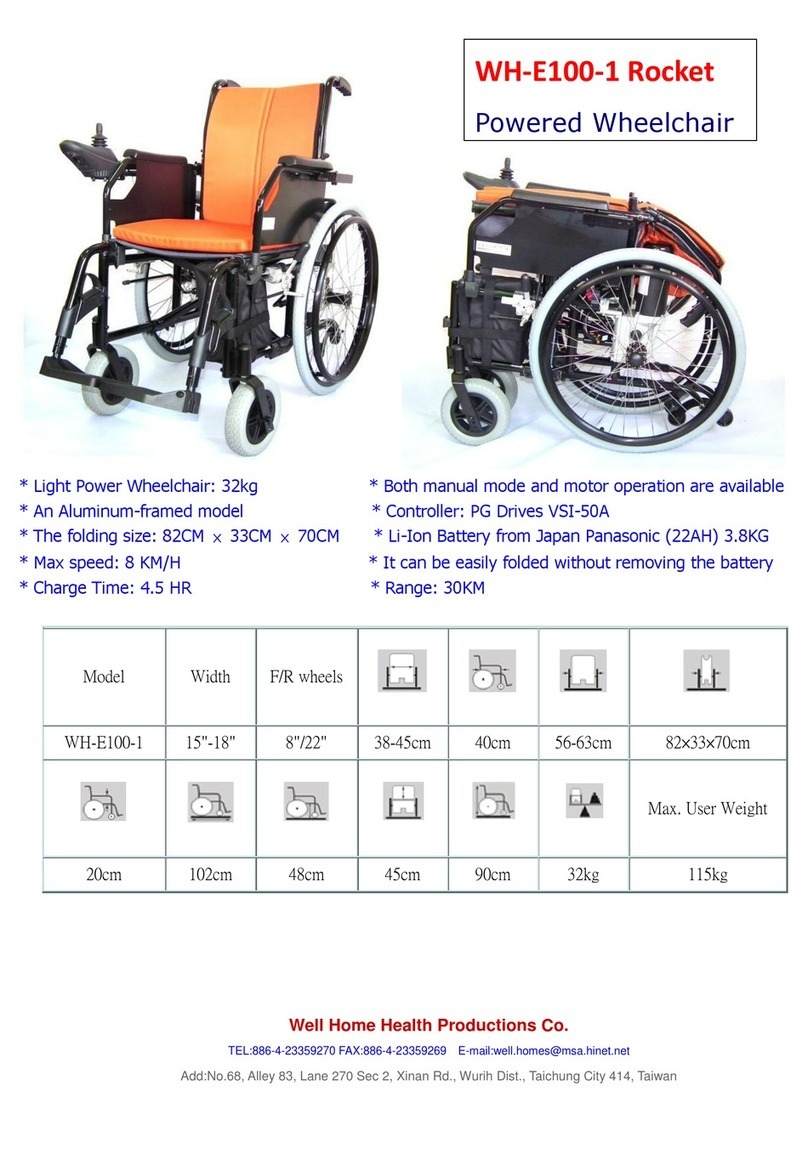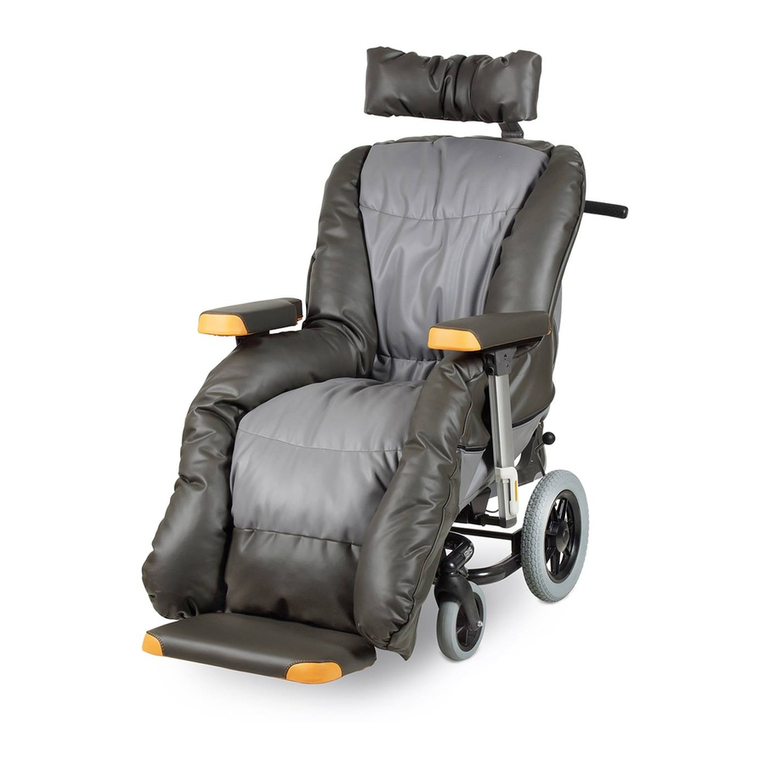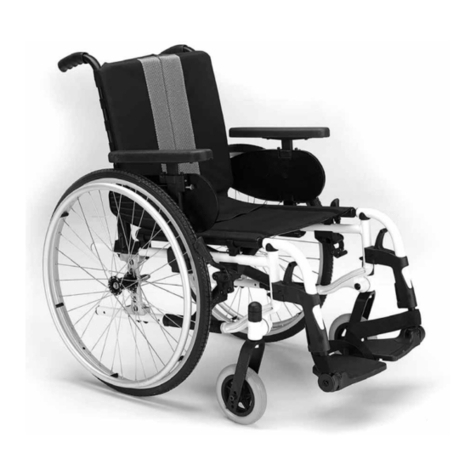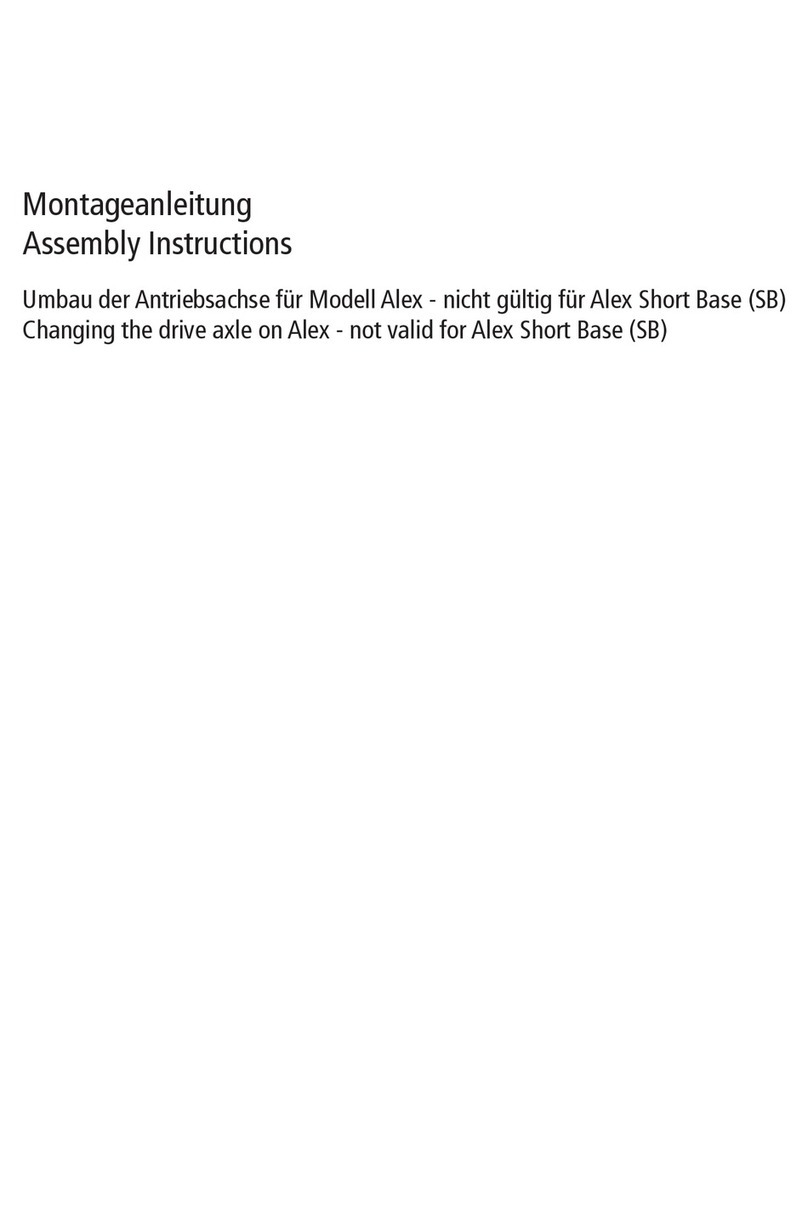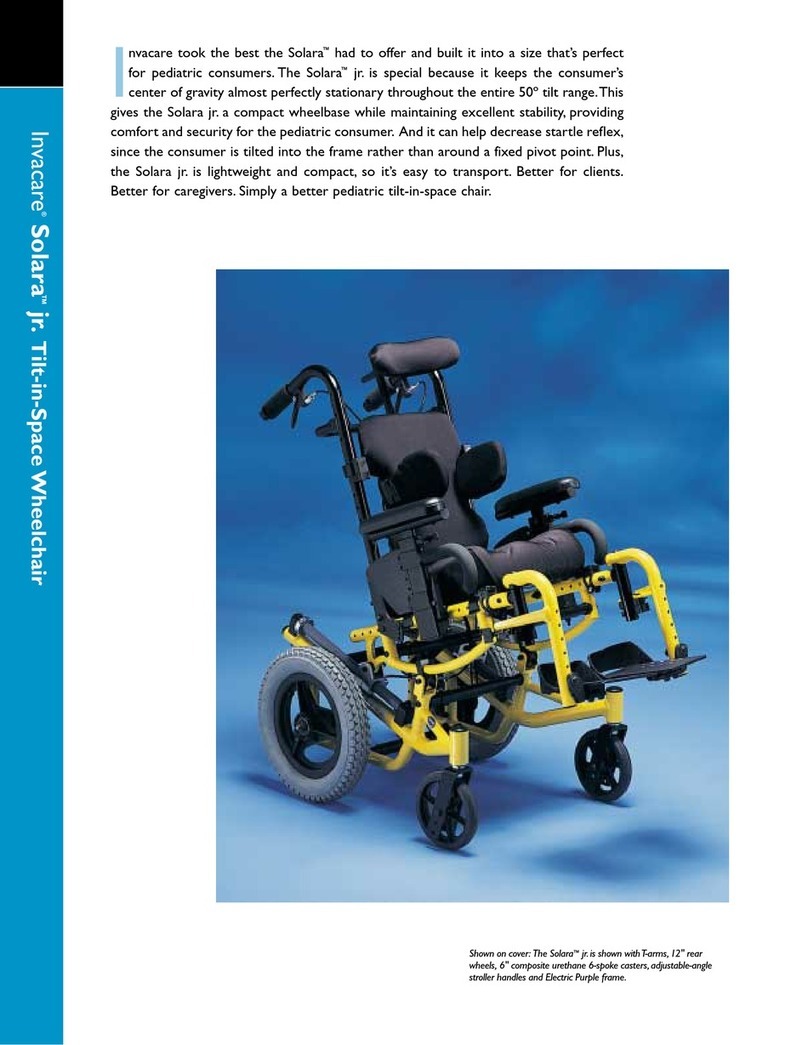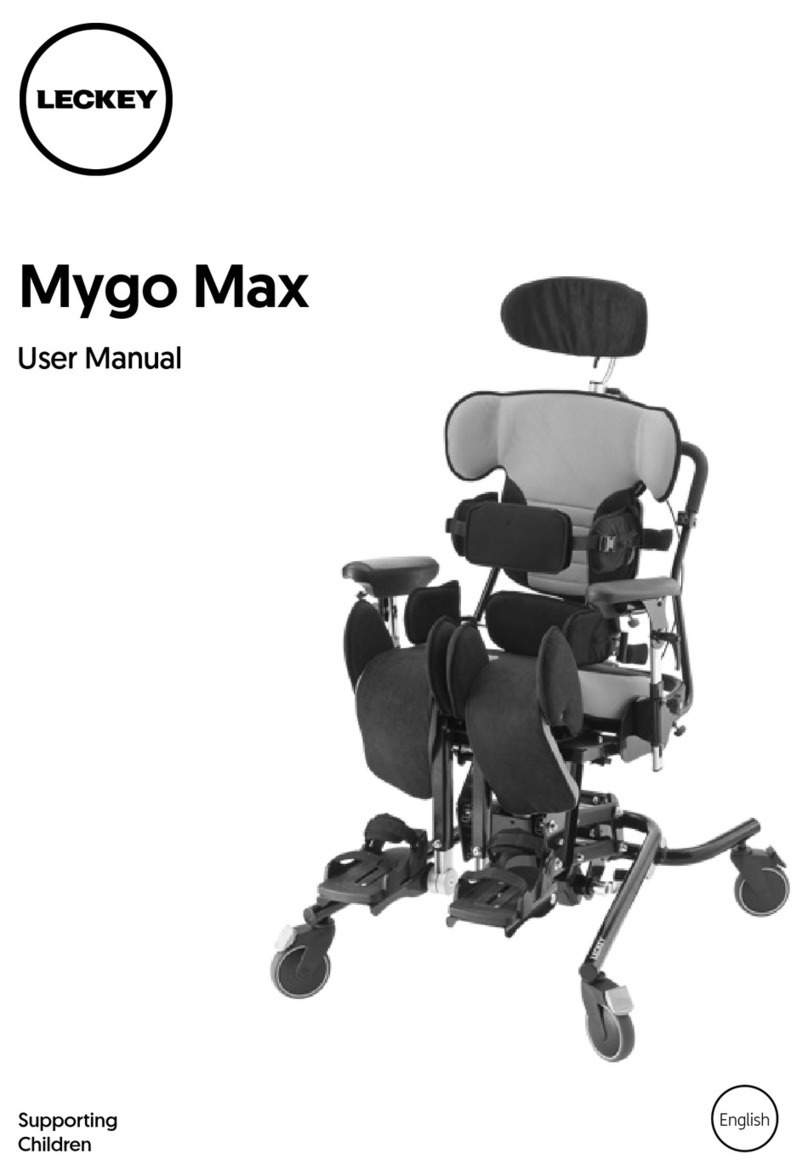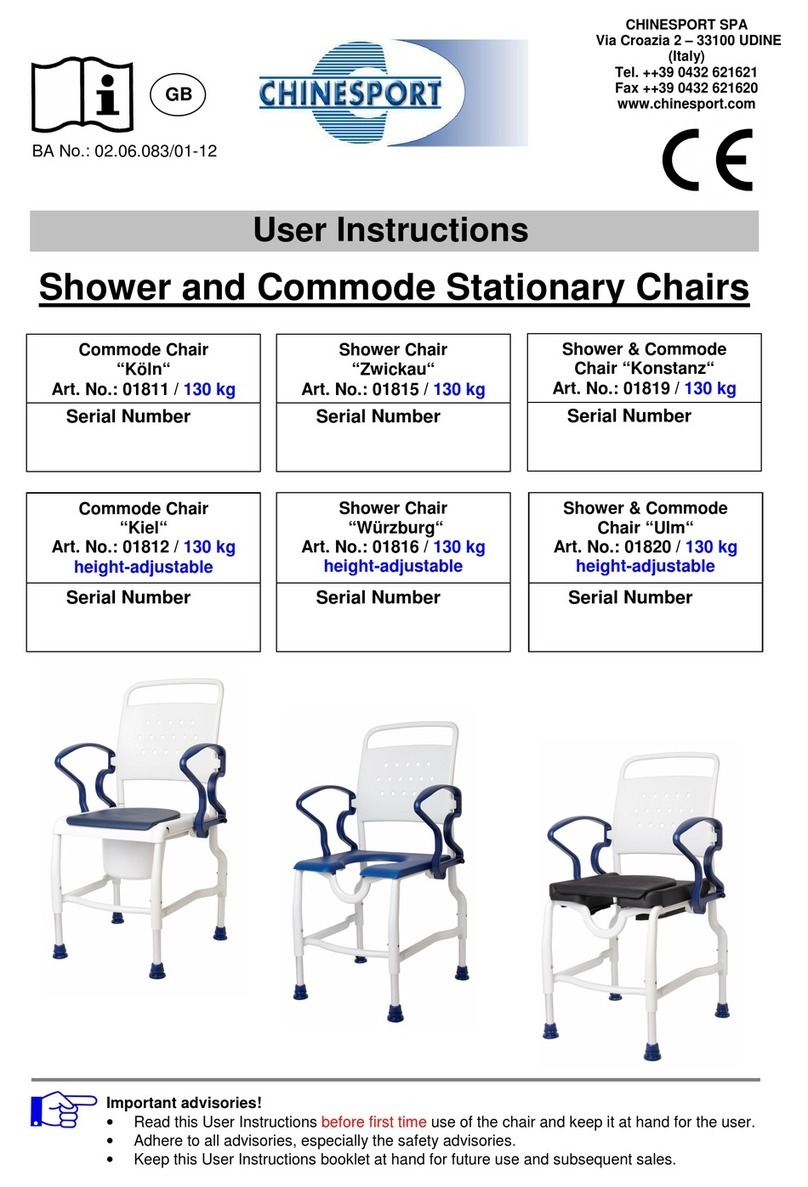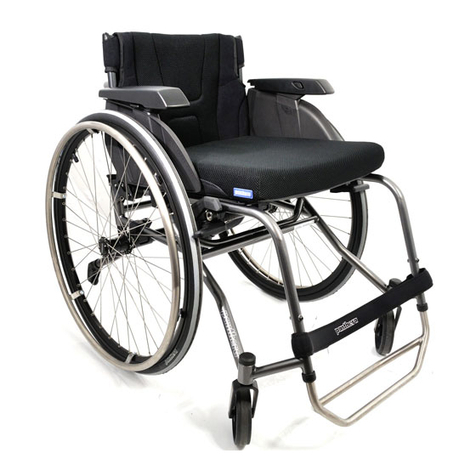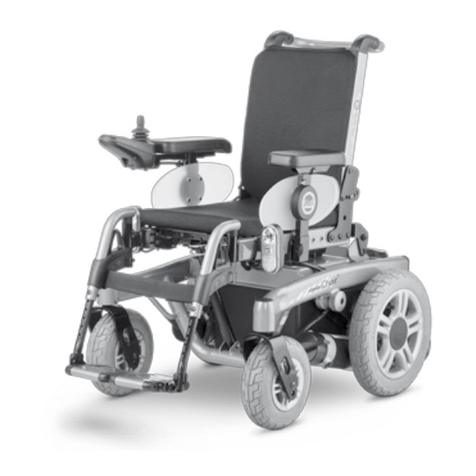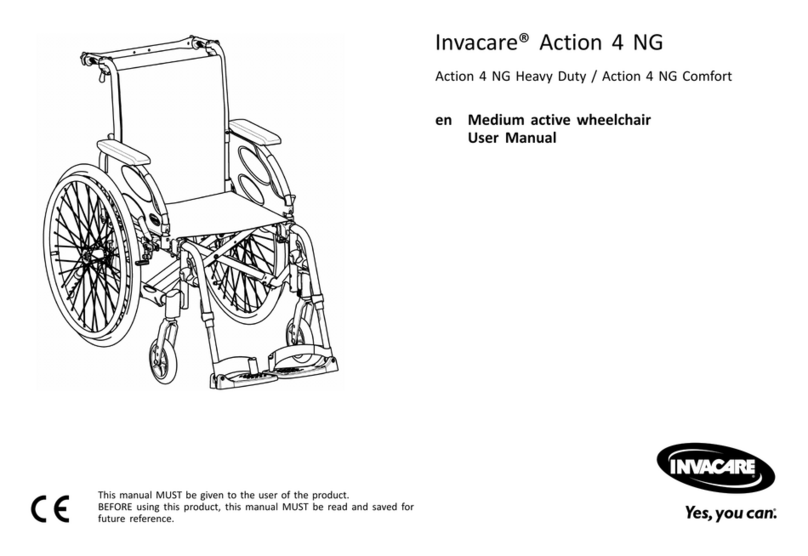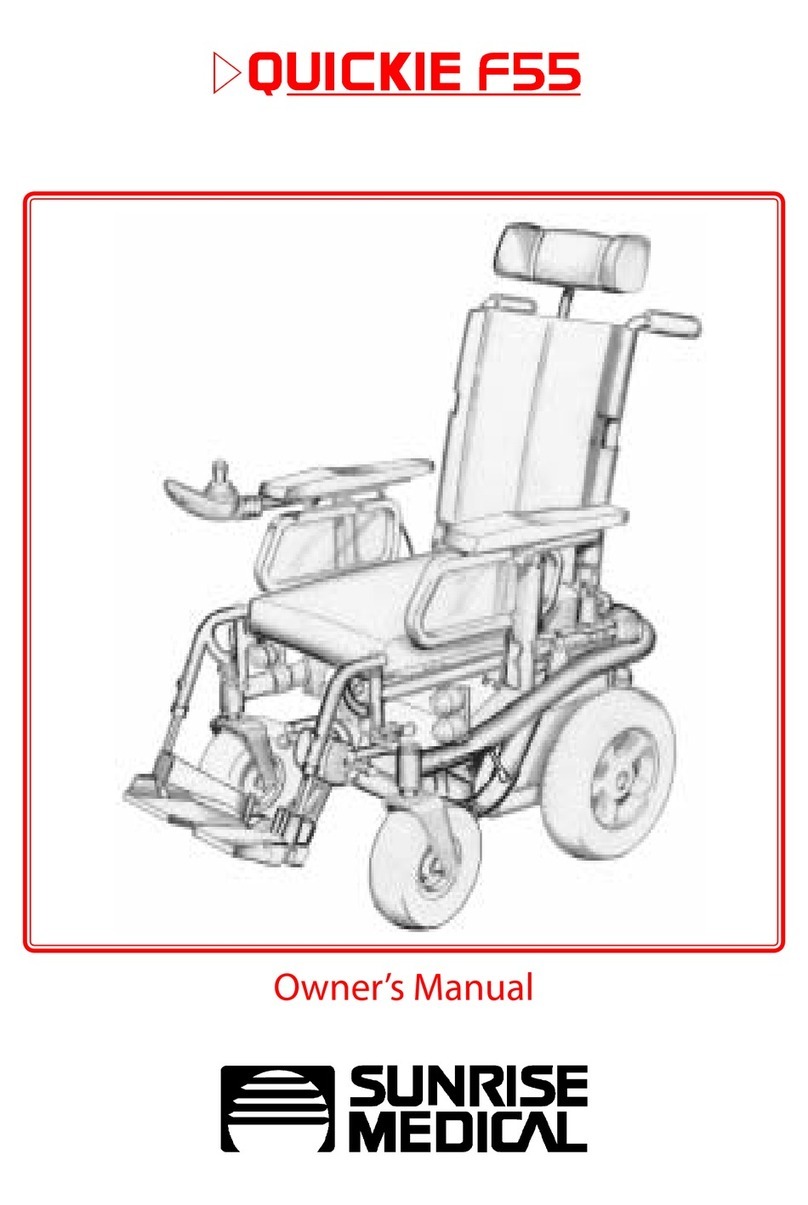
Gefahr!
Achten Sie beim Benutzen von Hebebühnen darauf, dass sich
montierte Sicherheitsräder außerhalb des Gefahrenbereichs
benden.
Gefahr!
Sichern Sie Ihren Rollstuhl auf unebenem Gelände oder beim
Umsteigen (z. B. ins Auto) durch Betätigen der Bremse.
Gefahr!
Bei Oberschenkelamputation müssen die Sicherheitsräder verwendet
werden.
Gefahr!
Achten Sie vor Fahrtantritt auf den korrekten Luftdruck der von Ihnen
verwendeten Bereifung. Bei den Antriebsrädern muss er mindestens
3,5 bar (350 kPa) betragen.
Die Kniehebelbremsen sind nur bei ausreichendem Luftdruck und
korrekter Einstellung wirksam (siehe Kapitel "Bremse").
Gefahr!
Die Feststellbremsen sind nicht dazu vorgesehen, den Rollstuhl
während der Fahrt abzubremsen. Sie sichern den Rollstuhl gegen
das Wegrollen. Wenn Sie auf unebenem Boden anhalten, ziehen Sie
immer die Feststellbremsen an, damit der Stuhl nicht wegrollt. Ziehen
Sie die Bremsen auf beiden Seiten an, sonst könnte der Stuhl
kippen.
Gefahr!
Sollte die Sitz- und Rückenbespannung beschädigt sein, tauschen
Sie diese bitte umgehend aus.
Gefahr!
Vorsicht beim Umgang mit Feuer, insbesondere brennenden
Zigaretten. Sitz- und Rückenbespannung könnten sich entzünden.
Gefahr!
Wenn und wann immer möglich, sollten Fahrzeuginsassen
während der Fahrt in einem Behindertentransportkraftwagen
(BTW) die im Fahrzeug installierten Sitze und die dazugehörigen
Rückhaltesysteme nutzen. Nur so sind Insassen bei einem Unfall
optimal geschützt. Unter Verwendung der von SUNRISE MEDICAL
angebotenen Sicherungselemente und dem Einsatz geeigneter
Rückhaltesysteme, können die Rollstühle als Sitz beim Transport
im Behindertentransportkraftwagen genutzt werden. (Siehe Kapitel
"Transport").
Gefahr!
Achten Sie stets darauf, dass die Steckachsen an den
Antriebsrädern richtig eingestellt und eingerastet sind. Bei nicht
gedrücktem Knopf der Steckachse darf sich das Antriebsrad nicht
entfernen lassen.
Gefahr!
Bei Verwendung von Leichtmetallgreifringen kann es beim
Abbremsen aus schneller Fahrt oder auf längeren Gefällestrecken
zum erhitzen der Greifringe kommen.
Gefahr!
Wenn der Rollstuhl längere Zeit direkter Sonneneinstrahlung
ausgesetzt war, können Teile des Rollstuhls (z.B. Rahmen,
Beinstützen, Bremsen und Seitenteil) heiß (>41°C) werden.
Gefahr!
Zur Vermeidung von Handverletzungen greifen Sie bei der Fahrt
mit dem Rollstuhl nicht zwischen die Speichen oder zwischen das
Antriebsrad und die Radbremse.
Gefahr!
Den Rollstuhl nicht an Steigungen / Gefällen > 10° verwenden.
Den Rollstuhl nicht auf schlammigem oder vereistem Grund
verwenden.
Den Rollstuhl nur dort verwenden, wo auch Fußgänger zugelassen
sind.
Hinweis!
Sowohl die Wirkung der Kniehebelbremse als auch das
allgemeine Fahrverhalten sind vom Luftdruck abhängig. Mit korrekt
aufgepumpten Antriebsrädern und gleichem Luftdruck auf beiden
Rädern lässt sich Ihr Rollstuhl wesentlich leichter und besser
manövrieren.
Hinweis!
Achten Sie auf eine ausreichende Proltiefe Ihrer Bereifung!
Beachten Sie bitte, dass Sie bei Fahrten im öffentlichen
Straßenverkehr der Straßenverkehrsordnung unterliegen.
Hinweis!
Tragen Sie im Dunklen möglichst helle Kleidung oder Kleidung
mit Reektoren, um besser gesehen werden zu können. Achten
Sie darauf, dass die seitlich und rückwärtig am Rollstuhl
angebrachten Reektoren gut sichtbar sind. Wir empfehlen
Ihnen auch das Anbringen einer aktiven Beleuchtung.
Hinweis!
Achten Sie bei Arbeiten mit dem oder Einstellungen am
Rollstuhl immer auf Ihre Finger!
Die Rollstühle, die in diesem Handbuch abgebildet und
beschrieben sind,
entsprechen möglicherweise nicht in allen Einzelheiten genau
Ihrem eigenen Modell. Dennoch sind alle Anweisungen trotz
möglicher Detailunterschiede völlig relevant.
Der Hersteller behält sich das Recht vor, Gewichte,
Abmessungen oder andere in diesem Handbuch aufgeführte
technische Daten ohne vorherige Benachrichtigung zu ändern.
Alle in diesem Handbuch aufgeführten Zahlenangaben,
Abmessungen und Kapazitäten sind ungefähr und stellen keine
präzisen technischen Daten dar.
Lebensdauer
Die vorgesehene Lebensdauer des Rollstuhls beträgt 5 Jahre.
Garantie
DIES BESCHRÄNKT IHRE GESETZLICHEN RECHTE IN
KEINER WEISE.
Garantiebedingungen
1) Reparatur oder Ersatz erfolgt durch den autorisierten
Sunrise Medical Fachhandel.
2) Um die Garantiebedingungen zu erfüllen, falls an Ihrem
Rollstuhl unter diesen Vereinbarungen eine Wartung
durchgeführt werden muss, benachrichtigen Sie umgehend den
bezeichneten Sunrise Medical Kundendienst mit genauen
Angaben über die Art der Schwierigkeiten. Sollten Sie das
Produkt an einem Ort außerhalb des Zuständigkeitsbereichs
des bezeichneten Sunrise Medical Kundendienstes verwenden,
wird die Arbeit unter den „Garantiebedingungen“ von einem
anderen, vom Hersteller bezeichneten Kundendienst
ausgeführt.
3) Sollte ein Teil oder Teile des Rollstuhls innerhalb von 24
Monaten (5 Jahre für Rahmen- und Kreuzstrebe) nach
Eigentumsübertragung an den ursprünglichen Käufer und
vorausgesetzt, dass dieser dann noch Eigentümer des
Rollstuhls ist, Reparaturen oder eine Auswechslung benötigen
als Folge eines spezifischen Herstellungs- und Materialfehlers,
wird das Teil bzw. werden die Teile repariert oder kostenlos
ausgewechselt, wenn der Rollstuhl an den autorisierten
Kundendienst zurückgeschickt wird.
Hinweis:Diese Garantie ist nicht übertragbar.
4) Die Garantie gilt auch für alle reparierten oder
ausgetauschten Teile für die auf dem Rollstuhl verbleibende
Garantiedauer.
5) Auf Ersatzteile, die nach Ablauf der ursprünglichen Garantie
eingebaut werden, gewähren wir weitere 24 Monate Garantie.
6) Verschleißteile sind normalerweise von der Garantie
ausgenommen, außer der vorzeitige Verschleiß dieser Teile
wurde unmittelbar durch den ursprünglichen Fabrikationsfehler
verursacht. Zu diesen Teilen gehören u.a. Bespannungen,
Reifen, Schläuche und ähnliche Teile. Bei Elektro-Rollstühlen
sind darin auch Batterien, Motorbürsten etc. enthalten.
7) Die obigen Garantiebedingungen gelten für alle Produkt-
Teile von Modellen, die zum vollen Verkaufspreis erstanden
wurden.
8) Normalerweise haften wir nicht, wenn eine Reparatur oder
Ersatz des Rollstuhls aus den folgenden Gründen erforderlich
ist:
a) Der Produkt oder Teile davon wurden nicht korrekt gewartet
oder im Einklang mit den Empfehlungen des Herstellers (siehe
Angaben in der Gebrauchsanweisung und / oder im
Technischen Handbuch) instand gehalten .Verwendung von
anderem als dem spezifizierten Originalzubehör.
b) Der Rollstuhl oder ein Teil des Rollstuhls wurde durch
Nachlässigkeit, Unfall oder unsachgemäße Verwendung
beschädigt.
c) Änderungen am Rollstuhl oder an Teilen, die von den
Spezifikationen des Herstellers abweichen oder Ausführung
von Reparaturen vor der Benachrichtigung des Kundendiensts.
Garantie
DEUTSCH
UniX Rev 1 17
UniX Rev 1























